At least those youngsters on the Montana family farm like to wander but they’re always raised in the dark and confined interiors of old granaries. I’ve often wondered if GHO chicks raised in trees do the same thing at this tender age but I have little experience with that situation.
- A note about age and terminology. I never know for sure whether to call GHO youngsters of this approximate age chicks or fledglings. They’ve obviously left the nest so maybe fledglings would be more accurate but I’m rarely sure if they can actually fly or not. Maybe some can and some can’t and others are in transition. I did see one about this age fly off of an old motorcycle it was perched on so maybe they should be called fledglings but I’ll stick with chicks for this post.
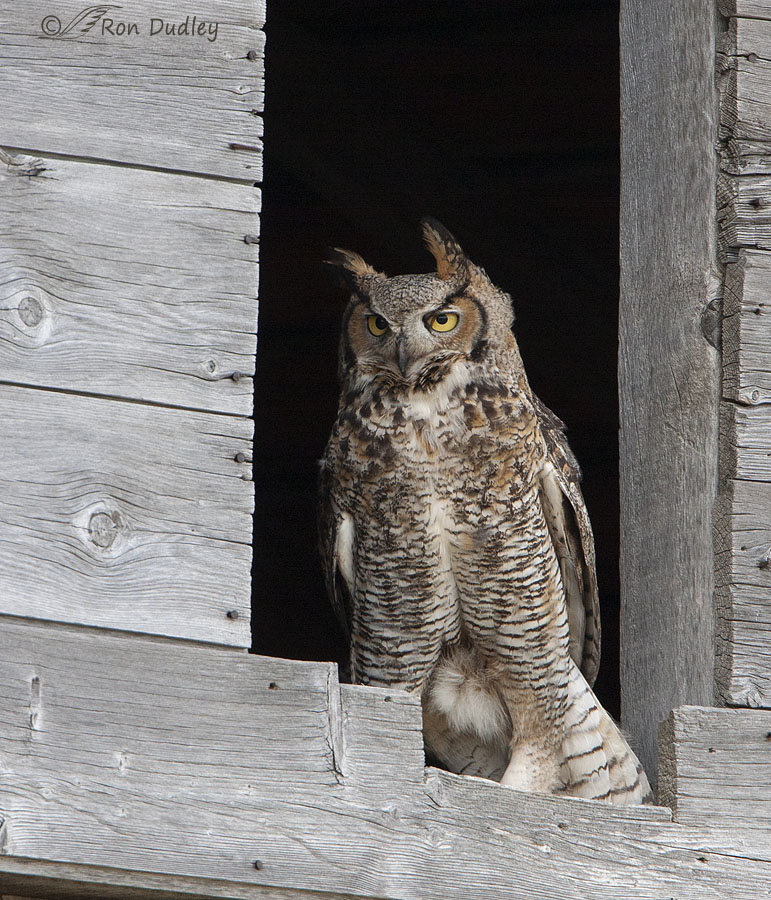
This is one of several old granaries they’re always raised in and the owl is one of the pair of adult birds that has been on the farm for years. These owls aren’t particularly fond of being “watched” but they almost never fly off when they’ve had enough gawking. They just turn around and hop onto one of the rafters in the darkness of the interior and I never bother them in there. I allow them their sanctuary.
This owl was in the process of turning around before hopping onto an interior rafter which is why its tail is spread and its upper legs are better defined than usual. It’s ear tufts are bent by the omnipresent Montana springtime breeze (breeze beats the hell out of the wind that’s so common in the area). And you’ll notice that I caught the nictitating membrane of its left eye partially open/closed.
At dawn or dusk I can find their chicks almost anywhere although they spend most of their daylight hours inside the granaries. On this early evening I found this youngster at the base of one of the corners of the same granary its nest had been in (and the same granary in the previous photo).
Maybe this bird looks angry or threatening but it was only yawning as it squinted into the late afternoon sun.
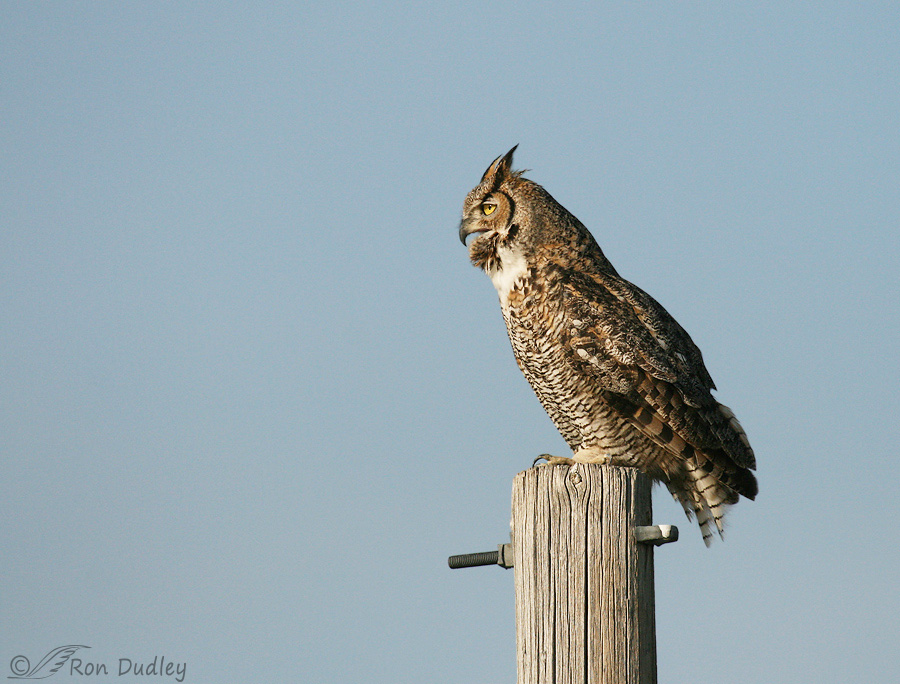
I’ll use the next two photos to set the stage for the last one. This adult was calling, probably to its mate though I had no idea where the other bird was. The perch might look like the top of a utility pole but it isn’t.
It’s one of the large poles set into the ground to support a two-story kid’s fort that was never completed. The adult in the previous photo was perched on top of the pole on the left. I took this shot one evening when I stepped out of the house to enjoy the sunset and looked toward the distant fort and noticed the silhouettes of two adult owls. Both birds were facing the sunset colors as if they were enjoying them. I’ll bet they were.
But adults aren’t the only owls to enjoy sunrises and sunsets from the fort which is some distance away from any granary that owls use for nesting. Notice the ladder leading up to the second floor.
Early one morning just before dawn I found this youngster on the same ladder. It was patient with me and stayed there until the sun rose in the east to provide better light. I’ve always loved these photos but I was fairly new to bird photography back then and all of my shots were too tight on the bird and ladder for my tastes today. I wish I’d backed off a little, physically or optically.
I’ve found owls of this age perched on almost any farm buildings and farm equipment you can imagine including granaries, barns, chicken coops, augers, plows, fuel tanks, tractors and combines. I’ve also seen them on old motorcycles, cars and in interiors of granaries far removed from their nests. They really get around at this age. Incidentally I’ve never seen a youngster in a tree although there aren’t many trees for them to choose from.
And I never see either of their parents nearby watching over them as they wander. I’ve always wondered about that…
Ron


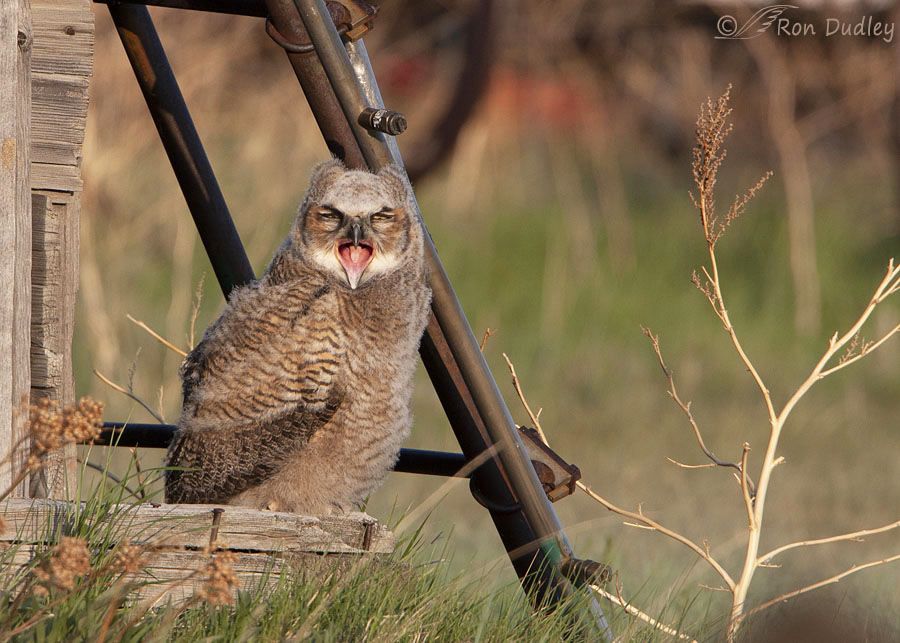
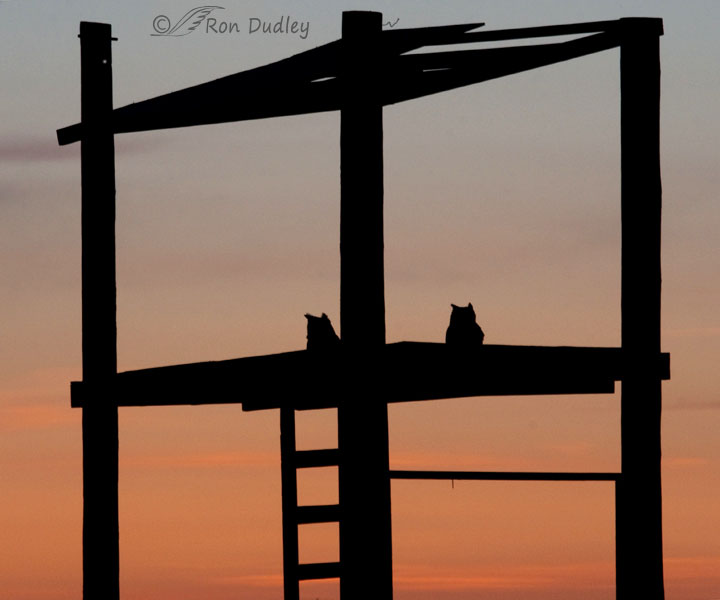
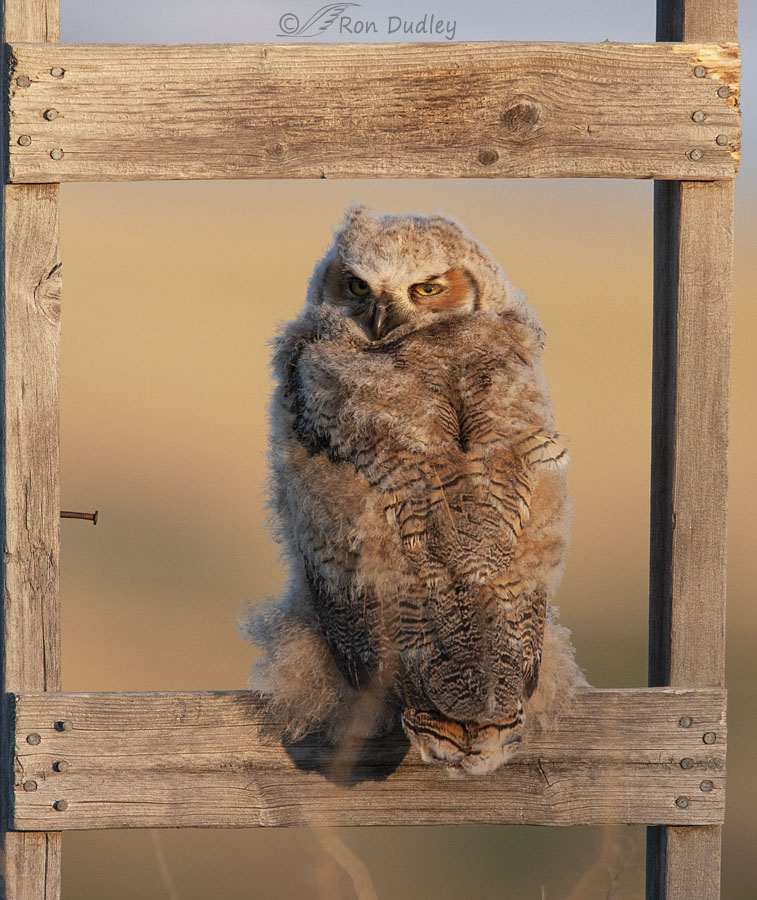
GHO do seem to fledge young. We have problems with them doing so in Salt Lake. We have had one in downtown off a very tall building, one who fledged from the capitol building in the middle of a protest and the U of U stadium birds that fledged into busy 400 south. In the wild they would be ok on the ground but these busy human occupied areas are not safe to spend the next week or two wandering around.
While living in New Mexico we had a GHO nesting in an old Cooper’s Hawk nest. As mentioned by your informative commentators, the youngsters tore that nest apart before they fledged. Seems so wasteful for a species which seems to depend upon them for breeding. Here in my south Florida neighborhood we only have screech-owls. I made a squeaking sound with my lips near one which was roosting in the dark and it flew right down and struck my hat! The claw marks persisted until I washed it. Not doing that again! (Squeaking not washing I mean.)
Wow, that’s quite a story, Ken!
Ron, I always learn from you and your readers. I learned quite a bit today. It sounds like these little owls have challenges and a lot of learning before they look like the 1st photo. Hopefully they live through it.
Thanks for another great post.
I learn a lot from my readers too, Alice. That’s actually one of the reasons I blog. Thank you.
In Wildlife Rescue, we call those “branches”. It is the stage in between chicks and fledglings.
GHO’s are terrible nest builder, they often won’t even build and instead use an old hawk nest.
Often, as the chicks grow and gain weight, the nest fall apart and the chicks fall or have to branch out.
They can not technically fly at the brancher stage,
however, they can climb. Combined with heavy wing flapping giving them a little lift and their sharp talons, they actually will climb back up the trunk after falling(sometimes).
This is a tricky and vulnerable stage because the, not so smart GHO’s, that don’t climb back up, are easy prey for bobcat, and coyote.
As raptor rehabilitators, my husband and I, often put these young guys back up in the trees near their nest sights when they come down.
Or keep them in rehab until their flight feathers are usable and then put them back.
GHO chicks stay with their parents for the first 9 months of their lives so it is vital to always get them reunited.
Here in Napa California, putting branchers back can be scary. The parents often dive bomb and attack, but it’s worth it.
Thank you for the beautiful posts
Long time viewer, first time making a comment.
Thanks for the info and welcome to commenting, Angela.
Years ago we watched 3 Baby Horned Owls grow, then leave the coop. What a thrill. Your photos are great. Beautiful birds. I noticed birds on our telephone line watching the sun go down. Starlings, Finches, and Doves. I think they noticed the beauty of a sunset more then most people. Thanks Ron!
Who knows what birds might appreciate on some level, Jean. Fun to think about.
It appears there are photo ops aplenty at your family farm which you take spectacular advantage of. To my untrained eye the evening silhouette image could be owls or cats. I like the ambiguity.
BTW, I sent this post a few hours ago; it appeared to send but I didn’t see it now.
WordPress does strange things sometimes, Lyle. Inconsistent and unpredictable. And frustrating.
Those photo ops are never often enough for me. Sometimes I go days and days and never have one with the owls and then one will surprise me and cooperate for a few minutes. I have to work at it but it’s work I enjoy.
Oooh. And ahhh.
Megathanks.
In a little I am heading out for a busy and stressful day. I will carry these glorious images with me.
I hope they help you get through it, EC. Thank you.
Great shots Ron! I think Louise answers your queries.
I’ve seen GHO youngsters out of a tree nest and on a nearby branch. That was a long time ago. Primarily now just hear them at night calling when they are in our vicinity. Was involved in banding GHO back in the 1970’s, parents stayed some distance as each youngster was brought down to the ground, banded and measured and returned to the nest. Not sure I would have done that alone, there were four of us – safety in numbers.
“Messing with them” can be dangerous! Most we ever did was shoo one on the porch into a dog kennel and take it back to the tree it came from as the dog and cat were WAY too interested in the puffed up clacking creature! 🙂 After a rest it came out and climbed the tree.
“Not sure I would have done that alone”
Maybe you’re not sure but I’m pretty sure I wouldn’t have the guts to do it! I have vivid memories of some film of one of the Craighead brothers (Frank or John of grizzly bear fame) scaling a cliff to get at a GHOW nest for banding and one of the adults attacking him on the cliff. Ripped his shirt too. Talk about vulnerable on that cliff! Thanks, Dick.
That is most assuredly the face of “I’ve had enough” in the first shot! Those legs certainly are powerful! The face of youngster in the second shot looks so human, I’m actually a little startled each time I scroll by. 😱
I could definitely go on and on about these wonderful shots of my favorite owl (apologies to Shorties), but I’ll wrap it up by saying that my favorite shot in this series is the couple in the fort. Definitely “wall worthy” or at least needs to be used as a prompt by a creative writing class. Gorgeous!
I’m glad you like the sunset fort photo, Marty. I thought it might only be special to me because of my emotional attachment to the farm.
Maybe we were relatives in a previous life because I’ve grown to love your family farm and a lot of the areas around you as I’ve seen them through your eyes over the years.
Thanks, Louise! I was about to write about my experience with owlets, then saw that you had covered it. I second your comments!
🙂
Ron and all – Young owls just hatched are typically called hatchlings; then nestlings, while still in the nest. Then they go through a ‘wandering’ phase, as you describe, where they leave the nest and ‘branch’ to other parts of the trees or their surroundings – we call them ‘branchers.’ Once they can fly, they are called fledglings. May not be the exact scientific nomenclature, but that’s how wildlife rehabilitators typically classify them. All owls, not just the Great Horneds do this. Obviously, for owls small enough to nest in cavities they find, there’s not a lot of room in there and at that age, even though their wing feathers are not all the way in, they need room to flap and build muscle. So they branch. Rehabilitators get them in a LOT at this age, as they will get knocked out of trees by crows, or simply end up on the ground by accident or intent and people pick them up thinking they are lost. If healthy, we take them back right away; if not, we’ll try to fix them up and then take them back to the nest or the nest area. The parents keep track of them visually and vocally and do continue to take care of them. And, as Judy says, they can ‘climb’ up a tree using their beak and sharp talons, flapping their wings for balance. But it is a dangerous pre-teen stage for them as they can definitely end up in dangerous situations – injuring themselves in a fall, being found or chased by a predator, or (particularly barn owls who nest in warehouses, lumber mills, farms) around dangerous machinery. They are pretty funny to watch, too, at this age as they contemplate a move, think, start to move, stop, take the leap, and fail to stick the landing. Even once they have some wing power, landing is a separate lesson. 🙂
Thanks for that info, Louise.
Yes, it is a dangerous stage for them. Once I photographed a pair of youngsters very near to that same spot on the bottom of the granary where the owl is in that second photo. One of them had an obviously traumatized eye that was swollen and almost always kept closed.
Thank you for another fascinating insight into the lives of birds, Louise. I always look forward to your comments!
And huge thanks from me too Louise.
I love Ron’s photos and am so grateful to him and his knowledgeable commentators for expanding my horizons.
Love that first photo Ron. Not sure about wandering, but earlier this year I was photographing a GHO and her two chicks in one of our riparian woods for a couple weeks, and then realized that there was only one. A couple weeks later while moving around the cottonwood trees looking for a better angle I discovered the missing chick on the ground dead. Not sure if it fell while wandering or was pushed out by the other, or possibly was just sick and died.
Everett Sanborn, Prescott AZ
Awww, that’s too bad, Everett. Makes me sad…
Thanks, Ron…Your photos are such a gift. I just read this and thought you might also enjoy it: BY JOY HARJO
To pray you open your whole self To sky, to earth, to sun, to moon To one whole voice that is you. And know there is more
That you can’t see, can’t hear;
Can’t know except in moments Steadily growing, and in languages That aren’t always sound but other Circles of motion.
Like eagle that Sunday morning Over Salt River. Circled in blue sky In wind, swept our hearts clean With sacred wings.
We see you, see ourselves and know That we must take the utmost care And kindness in all things.
Breathe in, knowing we are made of All this, and breathe, knowing
We are truly blessed because we Were born, and die soon within a True circle of motion,
Like eagle rounding out the morning Inside us.
We pray that it will be done
In beauty.
In beauty.
Thank you, Mary.
There’s certainly more in nature that I “can’t see, can’t hear”.
Ah……. SO Cute! Beautiful captures, Ron. Really love the “fort” where they are silhouetted 🙂 Actually, the ones raised in the trees here do wander around in the tree they are raised in and near by trees if they fall or just get over to them before they fledge. They have to “learn” to perch among other things and I will find them on a fat branch leaning against the trunk of the tree after a couple of falls. Their ability to climb with their beak and talons like a parrot is amazing!
Thanks for that feedback, Judy. I’ve only spent time with tree-raised youngsters one time (in a tree west of Havre on Highway 2) and that was only for a couple of hours so I really don’t have experience with them in that situation.
Marvelous series Ron!
Charlotte
Thanks, Charlotte.
What Stunning captures of a remarkable Owl, Ron!! Those eyes must scare the begebas out of their prey – if they even see the owl coming!! Many times when watching my favorite Eagle cams, I’ve seen night time attacks by owls & it’s always been a GHO!!! Your thoughts about the little ones made me go to Cornell’s website & would you believe they had na-da on the babies at all!! The only thing they had was there are usually 4 eggs in the clutch!! Cornell really disappointed me!! Hope one of your followers is a GHO specialist!! Loved every photo you posted. The little ones are such fluff balls!!
Cornell’s Birds of North America Online (a pay site) has quite a bit of info on young GHO’s but everything is so incredibly variable with that species that little of it is definitive, Thanks, Jo Ann.
‘Halt! Who goes there?’ My thoughts as I look as your first photo. That is beautiful for all the reasons you stated 😍 and more…the slightly spread feet/ legs and the wing edges look like a defiant ‘hands on hip’ pose; the tuft of feathers between the legs and tail…it is a one-time pose for sure. Such beautiful birds and unique coloring and feathers. My…I could go on and write a story of each photo! ❤️ Great post!
Kathy, In that first photo I can follow the muscles that power the lower legs, feet and talons all the way up to the middle of the owls’ body. At least that’s what I think I’m seeing. Pretty impressive. Thank you.